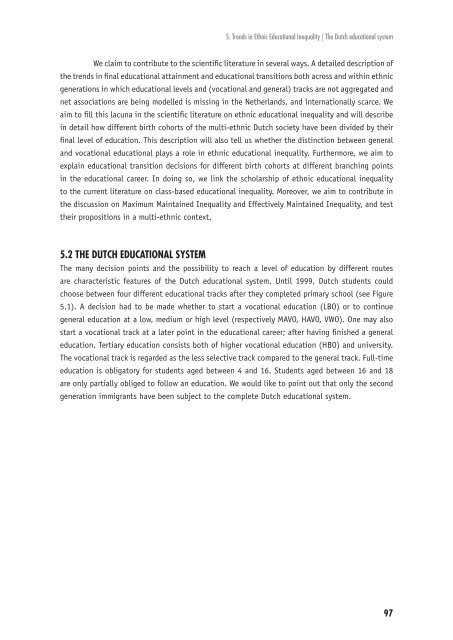Ethnic Hostility among Ethnic Majority and Minority Groups
Ethnic Hostility among Ethnic Majority and Minority Groups
Ethnic Hostility among Ethnic Majority and Minority Groups
Create successful ePaper yourself
Turn your PDF publications into a flip-book with our unique Google optimized e-Paper software.
5. Trends in <strong>Ethnic</strong> Educational Inequality | The Dutch educational system<br />
We claim to contribute to the scientifi c literature in several ways. A detailed description of<br />
the trends in fi nal educational attainment <strong>and</strong> educational transitions both across <strong>and</strong> within ethnic<br />
generations in which educational levels <strong>and</strong> (vocational <strong>and</strong> general) tracks are not aggregated <strong>and</strong><br />
net associations are being modelled is missing in the Netherl<strong>and</strong>s, <strong>and</strong> internationally scarce. We<br />
aim to fi ll this lacuna in the scientifi c literature on ethnic educational inequality <strong>and</strong> will describe<br />
in detail how different birth cohorts of the multi-ethnic Dutch society have been divided by their<br />
fi nal level of education. This description will also tell us whether the distinction between general<br />
<strong>and</strong> vocational educational plays a role in ethnic educational inequality. Furthermore, we aim to<br />
explain educational transition decisions for different birth cohorts at different branching points<br />
in the educational career. In doing so, we link the scholarship of ethnic educational inequality<br />
to the current literature on class-based educational inequality. Moreover, we aim to contribute in<br />
the discussion on Maximum Maintained Inequality <strong>and</strong> Effectively Maintained Inequality, <strong>and</strong> test<br />
their propositions in a multi-ethnic context.<br />
5.2 THE DUTCH EDUCATIONAL SYSTEM<br />
The many decision points <strong>and</strong> the possibility to reach a level of education by different routes<br />
are characteristic features of the Dutch educational system. Until 1999, Dutch students could<br />
choose between four different educational tracks after they completed primary school (see Figure<br />
5.1). A decision had to be made whether to start a vocational education (LBO) or to continue<br />
general education at a low, medium or high level (respectively MAVO, HAVO, VWO). One may also<br />
start a vocational track at a later point in the educational career; after having fi nished a general<br />
education. Tertiary education consists both of higher vocational education (HBO) <strong>and</strong> university.<br />
The vocational track is regarded as the less selective track compared to the general track. Full-time<br />
education is obligatory for students aged between 4 <strong>and</strong> 16. Students aged between 16 <strong>and</strong> 18<br />
are only partially obliged to follow an education. We would like to point out that only the second<br />
generation immigrants have been subject to the complete Dutch educational system.<br />
97












